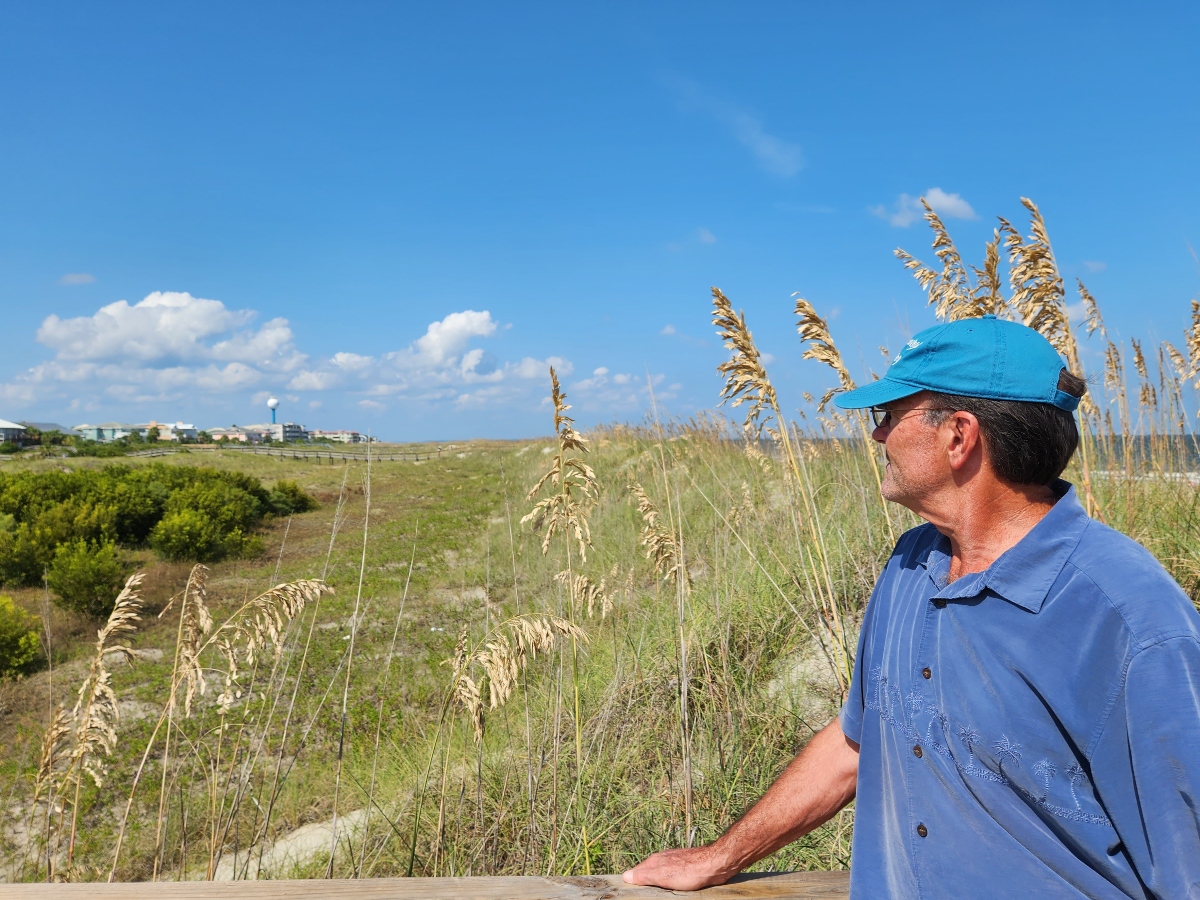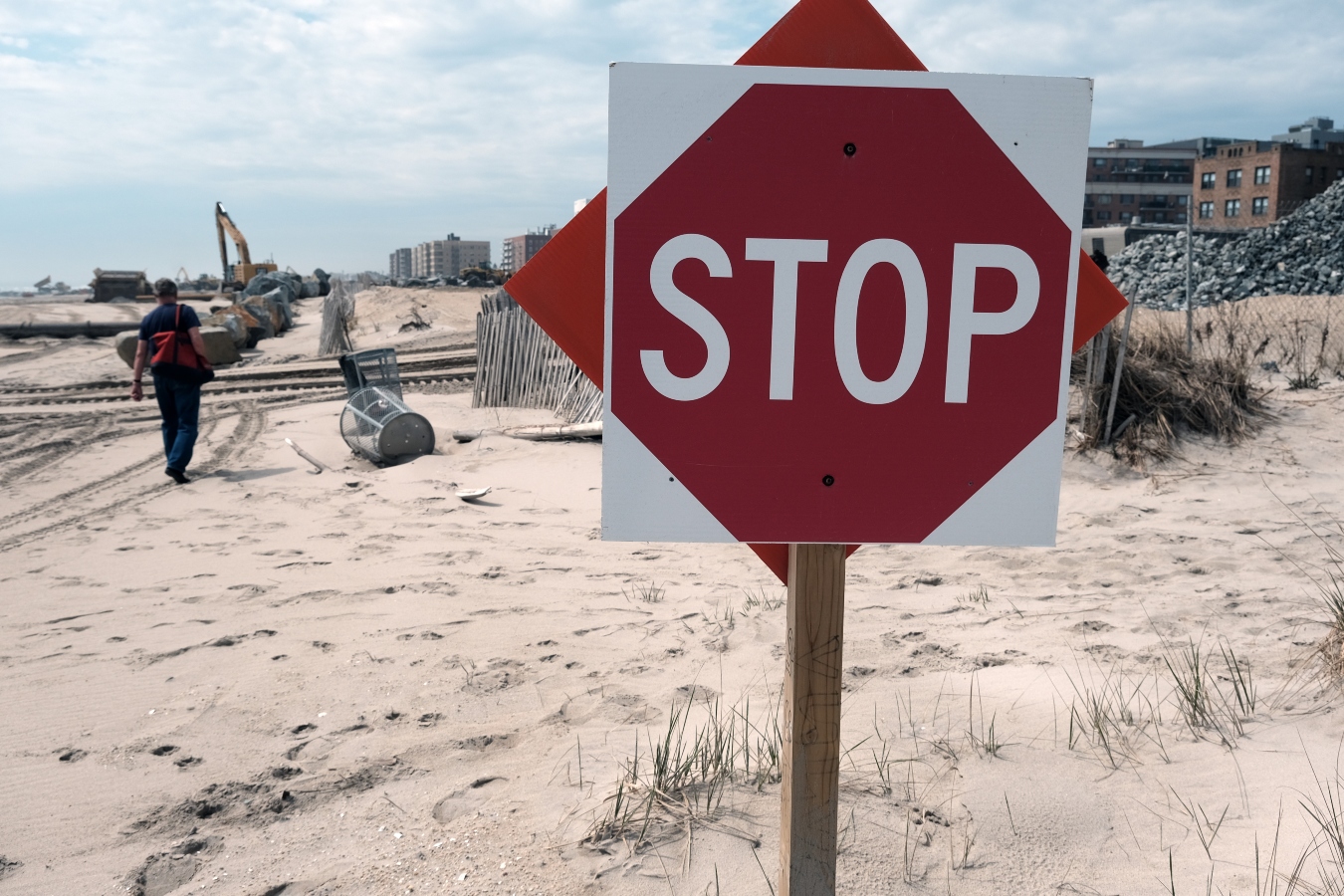This coverage is made possible through a partnership with Grist and WABE, Atlanta’s NPR station.
Tybee Island in Georgia has a rain problem.
The small barrier island’s stormwater system, fed by storm drains across the coastal community, funnels into a pipe that comes out on the beach at the southern tip of Tybee. But that pipe gets regularly buried by sand.
“What happens is when it gets covered with sand, and the tide rises, there’s nowhere for the stormwater to go,” said Alan Robertson, a Tybee resident and consultant for the city.
The water backs up in the system and wells up out of the drains, flooding the roads. It’s a chronic problem, he said, that the city is trying to solve.
“The city has to clear this every day,” Roberston said.
Tybee’s not alone. All over the country, old stormwater systems struggle to keep up with increased rainfall due to climate change. Rising sea levels and groundwater — also from climate change — squeeze the systems from the other end. Infrastructure like roads, hospitals and wastewater plants need to be shored up against flooding. Residents need protection from heat, wildfire, floodwater, and other climate impacts.
All of that is expensive. The good news for local governments tackling these problems is that lots of state and federal money is out there to fund resilience projects. The recent federal infrastructure law and Inflation Reduction Act are adding hundreds of billions of dollars to the pot.
But there’s also bad news: The money is often hard to actually get, and that difficulty can amplify inequities for communities that need help the most.
“All these great numbers and these great programs means absolutely nothing if communities that need it most can’t have access to it,” said Daniel Blackman, a regional administrator for the U.S. Environmental Protection Agency.
The funding often comes through competitive grants, with applications that are complicated and highly technical. They take time and expertise that under-resourced local governments often lack.

“One of the major capacity constraints of a lot of these local governments are that they have few grant writers on staff,” said Michael Dexter, director of federal programs for the Southeast Sustainability Directors Network.
Local government staff with plenty of work on their plates can often struggle to keep track of the different funding opportunities, coordinate the necessary partners, or come up with the local match funding some grants require.
“A lot of communities shy away from going after grant funds just because of that,” said Jennifer Kline, the coastal hazard specialist with the Georgia Department of Natural Resources Coastal Management Program.
Without a dedicated, expert grant writer and plenty of staff, communities may miss out on these huge amounts of money. That’s especially true in communities of color where old, racist policies discouraged investment and growth, according to Nathaniel Smith, founder of the Partnership for Southern Equity and a 2018 Grist 50 honoree.
“If you look at many of the communities that face the greatest challenges, a lot of times people just assume that it happened by happenstance,” Smith said. “And that couldn’t be furthest from the truth.”
He pointed to redlining, a set of policies under which banks refused loans in areas deemed to be high-risk, which were primarily Black neighborhoods, as well as the construction of highways that obliterated thriving Black communities. There were also federal policies that encouraged suburbanization and white flight from cities. When schools are funded with property taxes so that wealthier and whiter areas have better equipped schools, that also amplifies the inequities, he said.
“All of these things have helped to facilitate a competitive advantage of, in particular, white communities and well-resourced communities,” Smith said.
For many of the same reasons, those same historically disinvested places — often communities of color — stand to be hit hardest by climate change: They often have less shade to reduce heat, are less protected from flooding, and the people who live there face more of the health problems that climate change makes worse.
The Biden administration is trying to address this disparity with its Justice40 initiative, which promises to put 40 percent of federal climate funding toward historically disadvantaged communities. The process for identifying those communities has been criticized for some of the metrics it uses, for failing to account for cumulative burdens, and for not explicitly incorporating race. Because it’s broken down by census tract, Dexter said, the program can miss “localized need.” In places where a poor neighborhood is near a wealthier one, for instance, the average income across the tract could be too high to qualify.
“There’s still obviously uncertainty about how that’s gonna be implemented in some of these various different grant competitions,” he said.
And communities that qualify still have to successfully apply for and win those grants.
Through a program called the Justice40 Accelerator, Smith’s group and several partners offer funding and technical support to help eligible places get that money. The program has so far trained two cohorts, a total of 100 environmental and community groups from across the country. Along with grant writing help and mentorship, the accelerator provides $25,000 to each participating organization to help them develop their proposals.
“It takes real resources and time and support to ensure that local communities are positioned to compete,” Smith said.
So far, the program boasts an 81 percent success rate for its cohorts’ grant applications, totaling more than $28 million in funding awarded.
Many of the state and federal agencies that dole out grants offer help as well. The EPA, for instance, recently announced $177 million in funding for 17 of what it’s calling Environmental Justice Thriving Communities Technical Assistance Centers. Their goal is to help “underserved and overburdened” communities access federal funds. The centers, mostly based at universities or environmental groups, will provide training on grant writing and management as well as practical assistance like translation services for community outreach and meetings.
“It’s not going to solve every problem,” said Blackman. “But what it’s going to do is it’s going to address the concern you have in those individuals being able to write and access federal funding and grants.”
Kline’s DNR Coastal Management Program also provides assistance in finding and applying for grants. Dexter said his group, the Southeast Sustainability Directors Network, does too.
What’s not clear is whether all of that is enough.
“I was going to say that’s the $100 million question,” Dexter joked. “No, that’s the $1 trillion, multiple-trillion-dollar question.”
And it’s just one of the looming questions in these early stages of the IRA and infrastructure law rollouts. No one knows yet if there’s enough help for places that need it, or if those communities know the help is out there. It’s also unclear whether the assistance programs will help local governments not just apply for and win grants, but administer them and deliver the projects on time — itself a time-consuming and difficult process.
There’s some reason for hope, Dexter said, even as communities scramble for funding and groups like his scramble to provide enough support: The new federal laws are designed to offer funding over several years, instead of immediately. This is an important lesson learned, he said, from 2009’s American Recovery and Reinvestment Act and its heavy emphasis on “shovel-ready” projects. This time, some of the funding can be used for planning, and there is a bit more time for cities to get their ducks in a row.
“Hypothetically, that leads to this great scenario where a community might come in, in year one, access planning funding, and then by year three or four be able to access the implementation funding for that project,” Dexter said.
That’s exactly the system Tybee Island is working with now. Robertson maintains a spreadsheet of projects that need funding. He has plans for how some of the work can unfold over multiple grant cycles.
“We’re in a pretty good space now,” he said. “We can be much more responsive to many more opportunities because we have identified these projects.”
While stormwater remains a problem, the city has gotten grants to build protective dunes and elevate flood-prone houses.
But Tybee Island got lucky: Robertson, a resident with grant-writing experience, stepped up after Hurricane Matthew devastated the island in 2016. The city contracted with him, and he deliberately worked to build up this grant capacity.
As the wave of new federal funding comes, other communities are looking for similar help.





